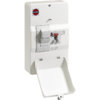I am refurb’ing my utility room and would like to move the CU so it is in a cupboard.
The new CU would be c2.5m from the current CU, and similar distance from the meter which is close to current CU (on outside wall).
How far can the CU be from the meter before a submain is required?
What (approx) would a submain cost?
The new CU would be c2.5m from the current CU, and similar distance from the meter which is close to current CU (on outside wall).
How far can the CU be from the meter before a submain is required?
What (approx) would a submain cost?




